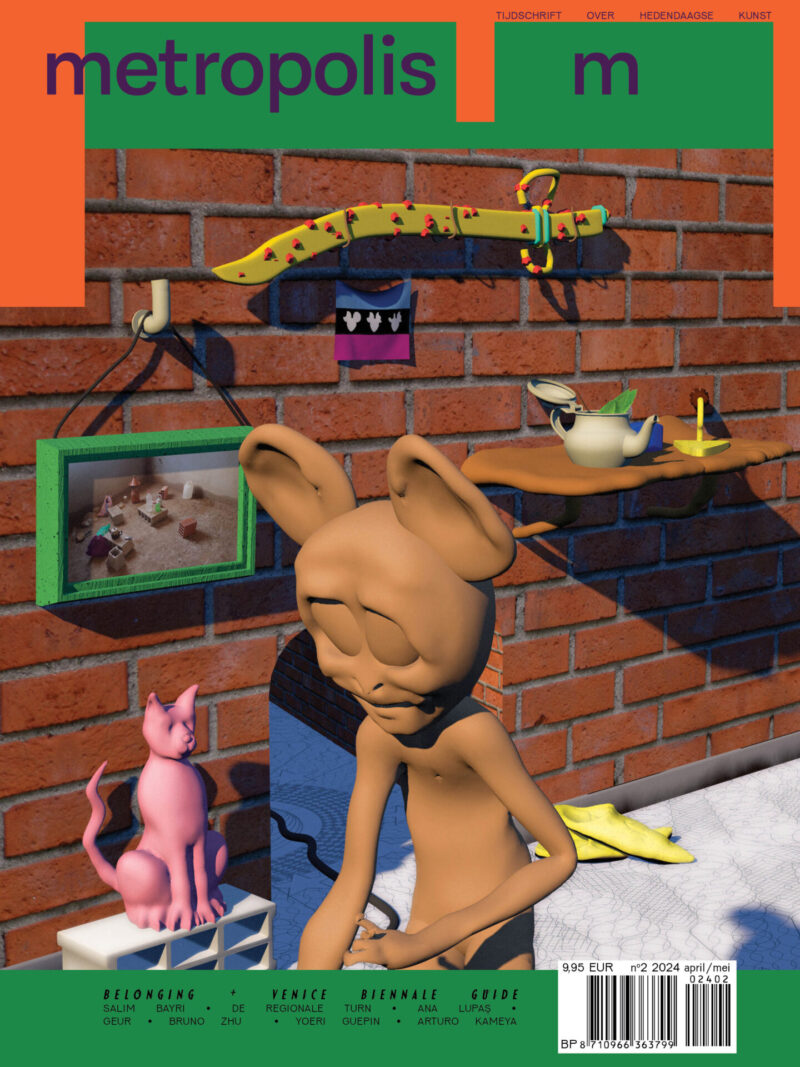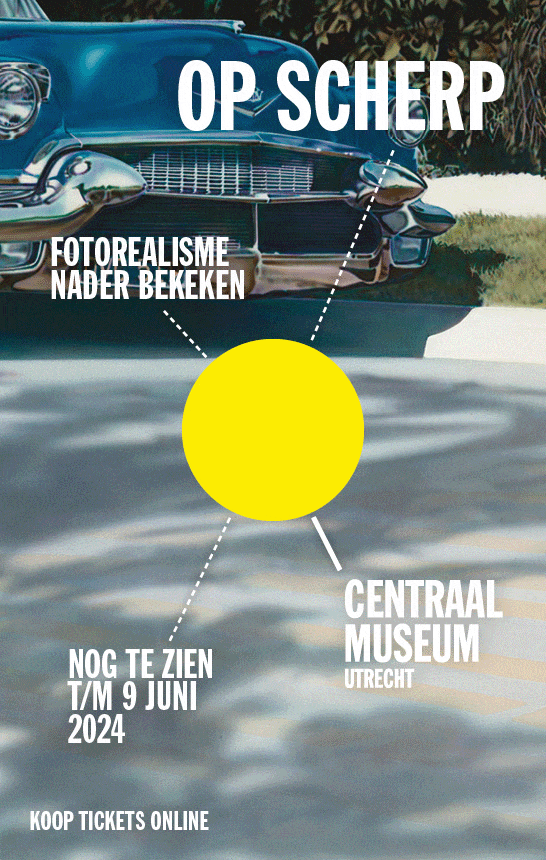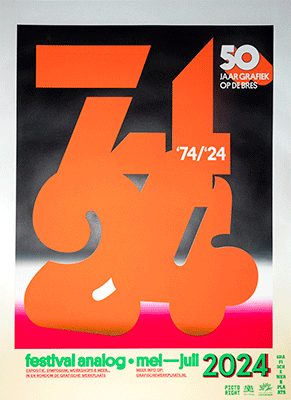
Maria Barnas in gesprek met Massimiliano Gioni
In het American Folk Art Museum in New York is een opmerkelijk grote maquette te vinden (twee mannen hoog) van een gebouw dat alle kennis van de wereld moet herbergen. Het schaalmodel is in de jaren vijftig gemaakt door Marino Auriti (1891–1980), een naar Amerika geëmigreerde Italiaanse automonteur met een grote belangstelling voor architectuur. Van de uitvinding van het wiel tot de ontwikkeling van de satelliet, zijn Encyclopedic Palace of the World moest een plek bieden aan alle belangrijke prestaties van de mensheid.
Drie jaar lang sleutelde hij aan zijn paleis van hout, metaal en plastic kammen en plaatste er als finishing touch een televisieantenne bovenop. De maquette, op een schaal van 1:200, zou in verwezenlijkte vorm 136 verdiepingen tellen, met een totale hoogte van 710 meter. Was Auriti een naïeve dagdromer? Gezien het patent dat hij regelde voor zijn levenswerk vermoedelijk niet.
Massimiliano Gioni, curator van de centrle tentoonstelling komende Biënnale van Venetië, werd geraakt door de dromerige ambitie van Auriti’s werk. Hij noemt zijn tentoonstelling The Encyclopedic Palace een eerbetoon aan Auriti. De tentoonstelling zal een enorme hoeveelheid werken omvatten, van schetsen van Rudolf Steiner tot werk van Roger Hiorns. Wat alles met elkaar verbindt is dat ze iets zichtbaar maken van de kracht van wat Gioni noemt: ’the images in your head.’
Ik spreek Gioni na een persconferentie in de Italiaanse ambassade aan de Tiergarten in Berlijn, een uit roze marmer opgetrokken paleis, dat – naar de verbeelding van Albert Speer onder het fascisme – in grootheidswaan niet onderdoet voor het Encyclopedisch Paleis van Auriti.
‘These sandwiches look horrible but if you want one…’ Massimiliano Gioni gebaart naar een schaal artificieel aandoende witte broodblokjes, met een patroon van smalle felroze en gifgroene strepen. ‘No thank you’, zeg ik. ‘They look nice, but not to eat.’ Gioni kijkt me aan en zwijgt. Ik ben bang dat ik hem heb beledigd. Hij is 39, net als ik, maar dat geeft me misschien nog niet het recht direct familiair te doen.
Mooi hoofd, denk ik, wanneer het in lachen uitbarst. Hij lacht echt. Een volle, genereuze, bulderende lach rolt door de zaal en echoot tegen de marmeren wanden. We formuleren lange, kromme zinnen met onvolledige gedachtensprongen in het Engels, die ik alleen onder tijdsdruk (ik heb een kwartier) en in een tweede taal durf te maken.
Maria Barnas: In the press conference you mentioned that Auriti’s construction was the first artwork you came across whose maker had applied for a patent. But he, as a car mechanic, would not have considered his structure an artwork, would he?
Massimiliano Gioni: ‘No, the question what we consider art is actually one of the premises of the show. Auriti was a painter, he did not think of himself as an artist, he just made paintings. He raises the question, which will hopefully go throughout the show, that you don’t know necessarily whether you are looking at an artwork or not – to a point where, when you look at a professional artist’s artwork, then maybe you think, I see through it, instead of looking at it. For me as a curator this became an interesting question when I understood that the artwork has to be an artwork, which is complete in itself, but also has to be a fragment of a story, a relic of a life. If you only look at it as an artwork, things get quite dry after a while. It’s an artwork after all. And so I have been thinking, how can you make a show in which the presence of things that might not be art, lead you to look at the art differently. It’s nothing original; it’s the way in which all museums except contemporary art museums operate.’
It is also the way artists work. They do not think ‘am I making an artwork’ while working. This question is not useful. Besides that, especially in your choice of older art, even of dead artists, I recognise images that could easily have been used as references by contemporary artists, who are often looking for off-the-beaten-track material.
‘First of all I think the broader audience of a show like this deserves more than just a list of names. And secondly I am thinking, what is there for artists to enjoy in a show like this. It is also a show where I am trying to do what I do not usually do or get to do.’
The metaphor of The Encyclopedic Palace works on many levels. It made me think of Borges. Auriti’s palace could have a place in a Borges story. But also the way in which Borges is looking at the universe, and making art not just as a single thing but understanding it as part of a bigger picture.
‘Borges is a great inspiration. We show the work of Xul Solar, who is an Argentinian artist and friend of Borges, and of who Borges said he was the only person ever to be comfortable in the universe, because Solar was inventing a language that he called neo-Creole and it was like a universal language, which of course only he could speak! So much for universality…’
I had to think of the list of animals of Borges. In The Analytical Language of John Wilkins he describes a certain Chinese Encyclopedia, The Celestial Emporium of Benevolent Knowledge, in which it is written that animals are divided into: ‘1. those that belong to the Emperor, 2. embalmed ones, 3. those that are trained, 4. suckling pigs, 5. mermaids, 6. fabulous ones, 7. stray dogs, 8. those included in the present classification, 9. those that tremble as if they were mad, 10. innumerable ones, 11. those drawn with a very fine camelhair brush, 12. others, 13 those that have just broken a flower vase, 14. those that from a long way off look like flies.’ This redefining of categories and shattering of landmarks of the thought (Foucault’s reaction to the list) is something you also seem to attempt for the understanding of art.
‘I hope so.’
The gesture you seem to make by naming the exhibition after this object, this strange, all encompassing object, is that what you aim at is in a way quite small, and meaningful if you consider Auriti’s structure as a one man’s feat and its universal meaning – but you can also see it as a megalomaniac vision.
‘ …’
Did you actively look for someone like Auriti, typically someone raised and educated before World War II? Someone raised to believe in grand gestures even after the war as he built his palace in the fifties, as opposed to the more recent generations of artists who seem to shy away from all encompassing visions?
‘…’
Maybe we lack vision in these times, since we are all politically correct, and share all kinds of polite perspectives on the world? It is not a coincidence that a lot of young artists look at Modernistic art and ideas to react on.
‘I am not sure this show deals with any Modernistic paradigm. First of all I don’t know what it is. It is also something that has been very much discussed in recent years and mostly it means black and white designy forms and I think reducing Modernity to just that is weird. I was a bit uncomfortable with the whole ‘is Modernity our history’ question of the last Documenta. It is clearly not a preoccupation of the show for me. If anything, it’s looking at another myth, maybe of modernity, or of the avant-garde, the myth of the eccentric, much like the Surrealists who looked at art brut, or the Surrealists who looked at art of the insane.’
That could be entering a rather conservative realm.
‘Yes. But I think paradoxically today we have a much more conservative way of thinking what art is, and what makes art good and what contemporary art is, so I was interested in this kind of somersault, of how you can go back to that tradition and it still being polemical, almost a hundred years later. By looking again at works that are more outsiderish, and finding they are still provocative, you wonder how that is possible. The show can be seen as dealing with the archaic and the occult and I am sure that will be one of the criticisms, that it flirts with this idea of the visionary.’
You said something very beautiful in the press conference, that the show is based on the question: what do you see when you close your eyes. What do you see?
Gioni lacht en zegt: ‘At the moment I see mainly the budget and I see numbers. This show is complementary to the show I did in South Korea, the 8th Gwangju Biennale (2010). This was about the image as a place where we fight against the passing of time. So the image is the place where – it may sound banal or a little overemphatic – a place where we fight death. We make images because people die. And we want to keep them with us. And poetry and literature could then be seen as a place where we come to terms with mortality. We have grown up in semiology and structuralist thinking that humans are the only creatures that have a language. If you think of the first half of the century, humans were said to be having a consciousness and an unconsciousness. In the second half of the century there was a sort of linguistic turn; people are humans because they have language. And more recently there has been the iconic turn, and if you think about it, people are the only animals that create images. This show is preoccupied with a revelation that may be banal but is also fundamental: we dream in images, we see things – even when we are blind. This show deals with the images in our head.’
Do you consider yourself a romantic?
‘I don’t know… I don’t see the… I don’t think of it when I am making a show but when I look at them in perspective, clearly there is something I connect with my sensibility. This is ultimately a show about the surreal, and when I think of myself as a kid, a lot of my passion for art grew out of Breton’s writing. So there is a symmetry, but it’s not… it took me more time to learn about some rational positions than others… I always sympathise more with the messy, the cacophonic, the surrealistic or the romantic but the irony is that Walter De Maria’s piece called Apollo’s Ecstasy (1990) will be a central part of the show. It proves that a calm Apollonic thinking can be part of my wild aesthetics too.’
Maria Barnas is kunstenaar en schrijver
Biënnale van Venetië
Il Palazzo Enciclopedico
Arsenale en Giardini, Venetië
1 juni – 24 november
In the press conference you mentioned that Auriti’s construction was the first artwork you came across whose maker had applied for a patent. But he, as a car mechanic, would not have considered his structure an artwork, would he?
‘No, the question what we consider art is actually one of the premises of the show. Auriti was a painter, he did not think of himself as an artist, he just made paintings. He raises the question, which will hopefully go throughout the show, that you don’t know necessarily whether you are looking at an artwork or not – to a point where, when you look at a professional artist’s artwork, then maybe you think, I see through it, instead of looking at it. For me as a curator this became an interesting question when I understood that the artwork has to be an artwork, which is complete in itself, but also has to be a fragment of a story, a relic of a life. If you only look at it as an artwork, things get quite dry after a while. It’s an artwork after all. And so I have been thinking, how can you make a show in which the presence of things that might not be art, lead you to look at the art differently. It’s nothing original; it’s the way in which all museums except contemporary art museums operate.’
It is also the way artists work. They do not think ‘am I making an artwork’ while working. This question is not useful. Besides that, especially in your choice of older art, even of dead artists, I recognise images that could easily have been used as references by contemporary artists, who are often looking for off-the-beaten-track material.
‘First of all I think the broader audience of a show like this deserves more than just a list of names. And secondly I am thinking, what is there for artists to enjoy in a show like this. It is also a show where I am trying to do what I do not usually do or get to do.’
The metaphor of The Encyclopedic Palace works on many levels. It made me think of Borges. Auriti’s palace could have a place in a Borges story. But also the way in which Borges is looking at the universe, and making art not just as a single thing but understanding it as part of a bigger picture.
‘Borges is a great inspiration. We show the work of Xul Solar, who is an Argentinian artist and friend of Borges, and of who Borges said he was the only person ever to be comfortable in the universe, because Solar was inventing a language that he called neo-Creole and it was like a universal language, which of course only he could speak! So much for universality…’
I had to think of the list of animals of Borges. In The Analytical Language of John Wilkins he describes a certain Chinese Encyclopedia, The Celestial Emporium of Benevolent Knowledge, in which it is written that animals are divided into: ‘1. those that belong to the Emperor, 2. embalmed ones, 3. those that are trained, 4. suckling pigs, 5. mermaids, 6. fabulous ones, 7. stray dogs, 8. those included in the present classification, 9. those that tremble as if they were mad, 10. innumerable ones, 11. those drawn with a very fine camelhair brush, 12. others, 13 those that have just broken a flower vase, 14. those that from a long way off look like flies.’ This redefining of categories and shattering of landmarks of the thought (Foucault’s reaction to the list) is something you also seem to attempt for the understanding of art.
‘I hope so.’
The gesture you seem to make by naming the exhibition after this object, this strange, all encompassing object, is that what you aim at is in a way quite small, and meaningful if you consider Auriti’s structure as a one man’s feat and its universal meaning – but you can also see it as a megalomaniac vision.
‘ …’
Did you actively look for someone like Auriti, typically someone raised and educated before World War II? Someone raised to believe in grand gestures even after the war as he built his palace in the fifties, as opposed to the more recent generations of artists who seem to shy away from all encompassing visions?
‘…’
LEES VERDER IN METROPOLIS M Nr 3-2013
NU IN DE WINKEL IN NEDERLAND EN BELGIË
EN IN DE WEBWINKEL
Maria Barnas





















